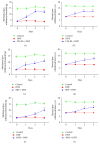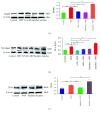Activation of GABAB Receptor Suppresses Diabetic Neuropathic Pain through Toll-Like Receptor 4 Signaling Pathway in the Spinal Dorsal Horn
- PMID: 30647535
- PMCID: PMC6311757
- DOI: 10.1155/2018/6016272
Activation of GABAB Receptor Suppresses Diabetic Neuropathic Pain through Toll-Like Receptor 4 Signaling Pathway in the Spinal Dorsal Horn
Abstract
Diabetic neuropathic pain (DNP) is a prevalent complication in diabetes patients. Neuronal inflammation and activation of Toll-like receptor 4 (TLR4) are involved in the occurrence of DNP. However, the underlying mechanisms remain unclear. Downregulation of gamma-aminobutyric acid B (GABAB) receptor contributes to the DNP. GABAB receptor interacts with NF-κB, a downstream signaling factor of TLR4, in a neuropathic pain induced by chemotherapy. In this study, we determined the role of TLR4/Myd88/NF-κB signaling pathways coupled to GABAB receptors in the generation of DNP. Intrathecal injection of baclofen (GABAB receptor agonist), LPS-RS ultrapure (TLR4 antagonist), MIP (MyD88 antagonist), or SN50 (NF-κB inhibitor) significantly increased paw withdrawal threshold (PWT) and paw withdrawal thermal latency (PWTL) in DNP rats, while intrathecal injection of saclofen (GABAB receptor blocker) decreased PWT and PWTL in DNP rats. The expression of TLR4, Myd88, NF-κBp65, and their downstream components IL-1 and TNF-α was significantly higher in the spinal cord tissue in DNP rats compared to control rats. Following inhibition of TLR4, Myd88, and NF-κB, the expression of IL-1 and TNF-α decreased. Activation of GABAB receptors downregulated the expression of TLR4, Myd88, NF-κBp65, IL-1, and TNF-α. Blockade of GABAB receptors significantly upregulated expression of TLR4, Myd88, NF-κBp65, IL-1, and TNF-α. These data suggest that activation of the TLR4/Myd88/NF-κB signaling pathway is involved in the occurrence of DNP in rats. Activation of GABAB receptor in the spinal cord may suppress the TLR4/Myd88/NF-κB signaling pathway and alleviate the DNP.
Figures






Similar articles
-
Effects of Duloxetine on the Toll-Like Receptor 4 Signaling Pathway in Spinal Dorsal Horn in a Rat Model of Diabetic Neuropathic Pain.Pain Med. 2018 Mar 1;19(3):580-588. doi: 10.1093/pm/pnx125. Pain Med. 2018. PMID: 28575508
-
Intrathecal baclofen, a GABAB receptor agonist, inhibits the expression of p-CREB and NR2B in the spinal dorsal horn in rats with diabetic neuropathic pain.Can J Physiol Pharmacol. 2014 Aug;92(8):655-60. doi: 10.1139/cjpp-2013-0463. Epub 2014 Jul 2. Can J Physiol Pharmacol. 2014. PMID: 24988216
-
Suppression of TLR4-MyD88 signaling pathway attenuated chronic mechanical pain in a rat model of endometriosis.J Neuroinflammation. 2021 Mar 5;18(1):65. doi: 10.1186/s12974-020-02066-y. J Neuroinflammation. 2021. PMID: 33673857 Free PMC article.
-
Systematic analysis of critical genes and pathways identified a signature of neuropathic pain after spinal cord injury.Eur J Neurosci. 2022 Jul;56(2):3991-4008. doi: 10.1111/ejn.15693. Epub 2022 May 27. Eur J Neurosci. 2022. PMID: 35560852 Review.
-
Meta-analysis of TLR4 pathway-related protein alterations induced by arsenic exposure.Biol Trace Elem Res. 2023 Jul;201(7):3290-3299. doi: 10.1007/s12011-022-03426-w. Epub 2022 Sep 27. Biol Trace Elem Res. 2023. PMID: 36166114 Review.
Cited by
-
The analgesic mechanism of electroacupuncture at the central level for neuropathic pain: a review of studies based on animal experiments.Front Neurol. 2025 May 29;16:1587471. doi: 10.3389/fneur.2025.1587471. eCollection 2025. Front Neurol. 2025. PMID: 40510205 Free PMC article. Review.
-
Pharmacological Modulation of Rate-Dependent Depression of the Spinal H-Reflex Predicts Therapeutic Efficacy against Painful Diabetic Neuropathy.Diagnostics (Basel). 2021 Feb 11;11(2):283. doi: 10.3390/diagnostics11020283. Diagnostics (Basel). 2021. PMID: 33670344 Free PMC article.
-
Sanguinarine Inhibition of TNF-α-Induced CCL2, IKBKE/NF-κB/ERK1/2 Signaling Pathway, and Cell Migration in Human Triple-Negative Breast Cancer Cells.Int J Mol Sci. 2022 Jul 28;23(15):8329. doi: 10.3390/ijms23158329. Int J Mol Sci. 2022. PMID: 35955463 Free PMC article.
-
Mechanism of Sanguinarine in Inhibiting Macrophages to Promote Metastasis and Proliferation of Lung Cancer via Modulating the Exosomes in A549 Cells.Onco Targets Ther. 2020 Sep 10;13:8989-9003. doi: 10.2147/OTT.S261054. eCollection 2020. Onco Targets Ther. 2020. PMID: 32982290 Free PMC article.
-
Myeloid Differentiation Primary Response Protein 88: An Important Therapeutic Target for Chronic Pain.J Pain Res. 2025 Mar 4;18:1061-1069. doi: 10.2147/JPR.S487685. eCollection 2025. J Pain Res. 2025. PMID: 40061432 Free PMC article. Review.
References
MeSH terms
Substances
LinkOut - more resources
Full Text Sources
Medical
Molecular Biology Databases

